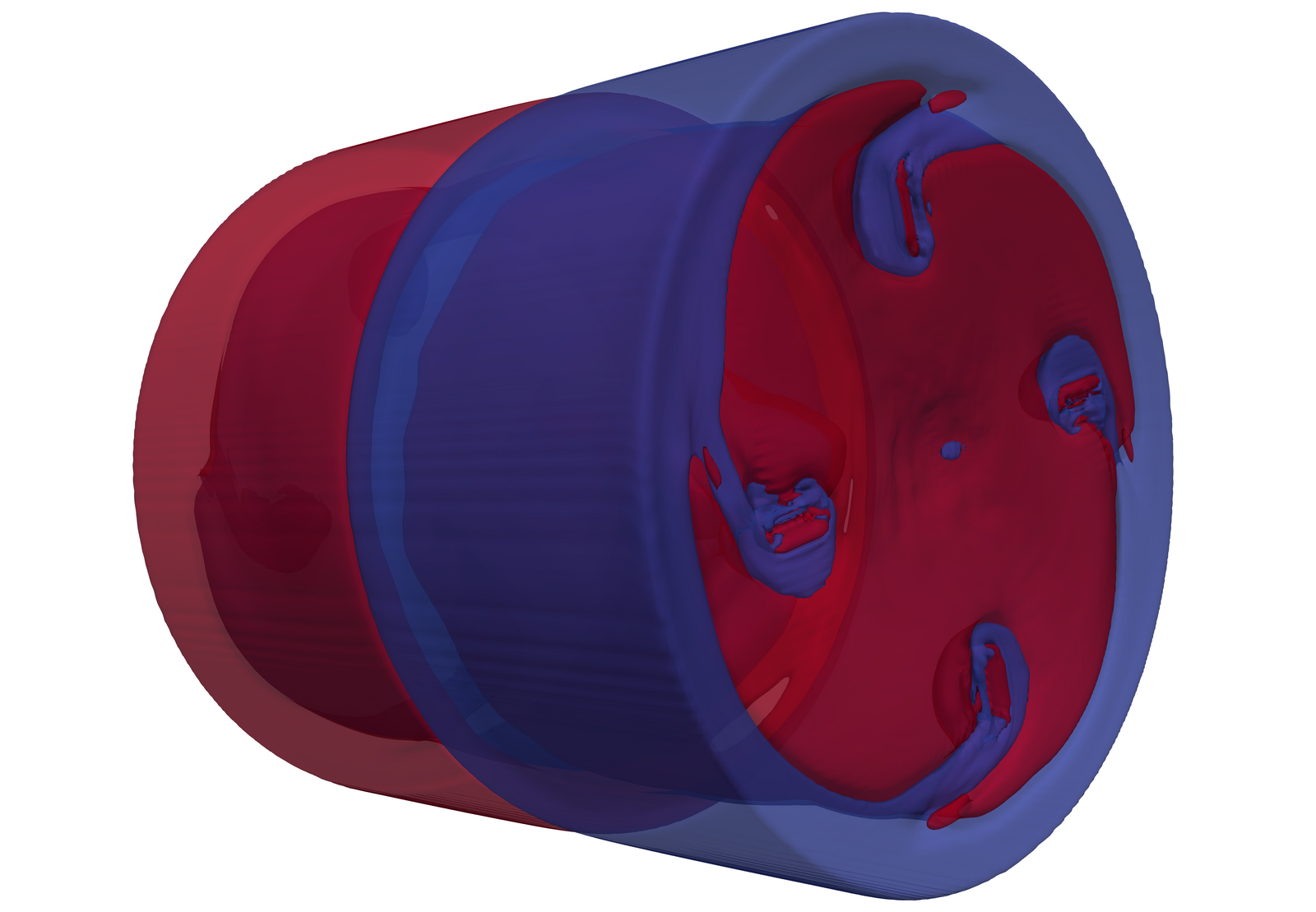ASTROPHYSICS
Spectral Simulations Supporting the DRESDYN Geodynamo Experiment
Principal Investigator:
Prof. Dr. Rainer Grauer
Affiliation:
Institute for theoretical physics I, Ruhr-University Bochum, Bochum, Germany
Local Project ID:
SpecDyn
HPC Platform used:
JUWELS CPU of JSC
Date published:
Abstract
Currently, the DRESDYN experiment is under construction. It aims to find and understand the mechanisms behind the excitation of a magnetic field due to the precessing motion of a conducting fluid. Such a precessing fluid is, for example, inside the core of the Earth, which is believed to sustain the Earth's magnetic field. To study the flow fields as well as the magnetic fields and to predict optimal parameter regimes for the DRESDYN experiment, numerical simulations are performed on JUWELS CPU using the code SpecDyn.
Introduction
The magnetic field of the Earth, which makes compass needles turn north and also causes the beautiful northern lights, was first discovered by the Chinese about 1000 years ago and has been actively investigated since the 17th century. Although the Earth's magnetic field has been studied for so long and is familiar to most people, its origin is still not certainly known.
The most popular theory is that of the geodynamo. It states that the molten metal in the Earth's core moves in such a way that it sustains the Earth's magnetic field, which would otherwise decay over time. This idea is based on Ampère’s law, which states that an electric current will produce a magnetic field. Since there are freely moving charges in the molten metal, these charges could indeed produce the Earth's magnetic field.
This leaves us with the question: How does the fluid have to move to produce a magnetic field similar to that of the Earth, and what could be the cause of that motion? There are basically two possible candidates. The first is thermal convection, which describes the motion of hot fluid into colder regions. The second is precession, the motion that a body performs when it is spinning about two different axes. This motion is also performed by the Earth since its rotation axis is tilted.
Project
The DRESDYN dynamo experiment, currently under construction at the Helmholtz-Zentrum in Dresden, will be used to study the creation of a magnetic field from molten metal due to precession motion. It consists of a cylinder of 2 meters in height and diameter, which will be filled with liquid sodium. Due to high efforts in engineering, this giant cylinder will be able to rotate about two different axes and is hoped to produce a magnetic field.
To generate insights about the strength and structure of the fluid flow and the possible magnetic field, different sensors will be attached to and around the cylinder. The downside of these physical measurements is that each sensor can only measure a small portion of a certain physical property.
For example, Hall sensors can only measure the magnetic field strength at a single point, and the UDV (ultrasound Doppler velocimetry) sensors only measure the fluid velocity along a straight line. Thus, the sensors will only display a fraction of the physics produced by the experiment. To overcome this difficulty, the DRESDYN experiment is complemented by numerical simulations.
These simulations are performed by the computer code SpecDyn. This software was developed especially for the DRESDYN experiment. SpecDyn is based on a pseudo-spectral method, which is highly accurate but misses the treatment of boundaries. In this case, the boundaries are the walls of the cylinder. To include boundary effects, the pseudo-spectral approach is combined with a so-called immersed boundary method, which is specially designed to treat boundaries with methods that are not feasible to do so on their own. This yields a simulation code that achieves very small numerical errors while being able to treat arbitrary bounding geometries.
As with nearly all fluid simulations, the problem of the range of scales requires a very high spatial resolution. That means that in the simulation, a large-scale object like the cylinder has to be modeled, but at the same time, small boundary layers that form in the fluid near the rotating walls of the cylinder have to be resolved. This necessitates a high-resolution simulation of an intrinsically three-dimensional problem. Also, the simulation has to run for hundreds of rotation cycles to create the fluid structures expected in the experiment. Therefore, a very fast computer is essential to run simulations in a reasonable amount of time. The computer of choice was the JUWELS CPU module, which makes it possible to efficiently run the code SpecDyn with thousands of CPUs at the same time.
The simulations not only demonstrated the structure of the fluid flow and the induced magnetic field but also identified parameter regimes where the excitation of a magnetic field from the motion of the molten metal is most likely. Furthermore, setups with blades at the cylinder's end caps were studied. These blades are also part of the real-world experiment in Dresden. The simulations showed that these blades will make it possible to put more energy into the flow structures that will cause the magnetic field and will shift the breakdown of the solid body fluid rotation to higher precession ratios. Figure 1 shows the fluid flow inside the cylinder and around the blades.

Fig.1: Contour plot of the axial velocity (~ 1% total axial velocity) at a precession ratio of 0.1 . (red: right direction, blue: left direction)
Publications
Wilbert, Mike, André Giesecke, and Rainer Grauer. "Numerical investigation of the flow inside a precession-driven cylindrical cavity with additional baffles using an immersed boundary method." Physics of Fluids 34.9 (2022).
Wilbert, Mike. Implementation and application of a pseudo-spectral MHD solver combined with an immersed boundary method to support the DRESDYN dynamo experiment. Dissertation, Bochum, Ruhr-Universität Bochum, 2023.